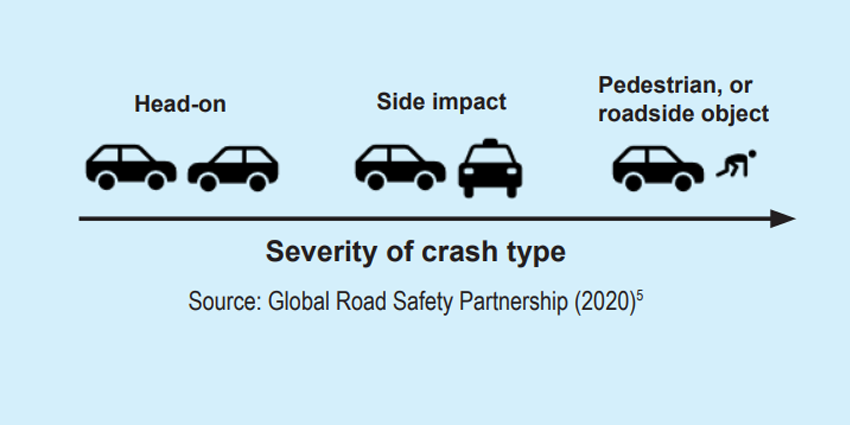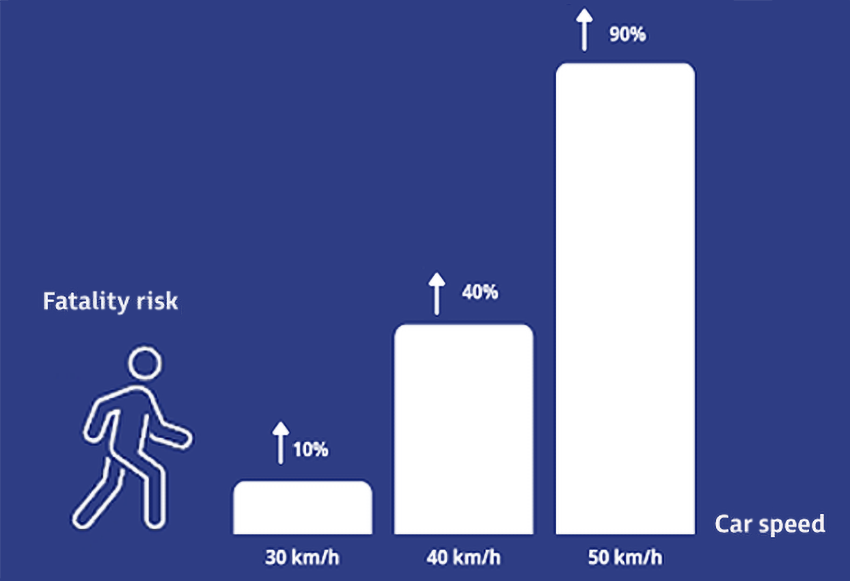This fact sheet was created by the Western Australian Centre for Road Safety Research at the University of Western Australia, and supported by the Road Safety Commission.
Why is speed important?
A vehicle’s speed has a major influence on the risk and severity of road crashes and crash-related injuries.1 2 3 4
As well as following the speed limit when we drive, we should adjust our speed to different road conditions to minimise these risks.2 3
Road conditions where you should consider reducing your speed include:2 5 6
- Weather. If the roads are wet or there is decreased visibility (e.g. fog).
- Pedestrians and cyclists. In areas of high pedestrian and cyclist traffic, to safeguard these vulnerable road users.
- Location considerations. In residential areas or areas with high levels of traffic.
- Type of road. On unsealed or highly congested roads.
- Wherever else it’s necessary to reduce risk to ourselves and others.
Adjusting your speed in these conditions can create more liveable and safer road environments for communities.6
The faster you drive, the longer it takes to stop
- Your driving speed influences the risk of injury to you, your passengers, and other road users.2 3 4
- Increasing your speed also increases your stopping distance (your reaction distance plus braking distance), meaning your risk of crashing is higher.2 3 7 8
- Stopping distance influences whether your vehicle will hit an object when coming to a complete stop. If a collision occurs, the stopping distance will influence the severity of the crash.2 3
- Stopping distances increase on wet roads. Driving at higher speeds extends stopping distances further.9
- You should adapt your speed to different road conditions to control your stopping distance. This can significantly reduce the risk of a crash and crash-related injury.
Injury risk and speed
- Faster speeds increase the risk and severity of crashes and injuries, and the risk of fatalities.2 5
- Injury and fatality risks are also influenced by the type of crash.5
- Adjusting your speed to road conditions can reduce these risks.
A 1 km increase in average speed increases the risk of a crash resulting in injury by 3%, and the risk of a fatal crash by 4-5%.
Lower speed limits?
- There is a push internationally towards 30 km/h speed limits in residential areas, city centres, and other locations with a high proportion of vulnerable road users.
- Lower speed limits can promote safer neighbourhoods to prevent injuries and save lives. 5 7 12
Is it always safe to travel at the speed limit?
- Abide by speed limits and reduce speed as needed in response to different road conditions.
- Driving at the speed limit is not always the safest option. For example, residential speed limits are usually 50km/h, but you may need to reduce your speed where there is high pedestrian and cyclist traffic, or in wet weather. 2 5
- For a safer journey, you should also consider widening the distance between your vehicle and the vehicle in front to increase your stopping distance. This can reduce the risk of crashing, particularly in wet weather or high congestion.2 3
References
Show more1 Khan Academy. Introduction to momentum.
2 New South Wales Government, Centre for Road Safety. Driving too fast.
3 Fletcher N, Australian Academy of Science. The physics of speeding cars.
4 Western Australian Government. WA Road Fatalities and Serious Injuries 2020.
5 Global Road Safety Partnership, Global Road Safety Facility - World Bank, 2020. Road Crash Trauma, Climate Change, Pollution and the Total Costs of Speed.
6 New South Wales Government, Towards Zero. Liveable and Safe Urban Communities Initiative.
7 Queensland Government, Department of Transport and Main Roads. Road safety research reports.
8 Transport and Infrastructure Council. National Road Safety Action Plan 2015-2017.
9 Queensland Government. Stopping distances on wet and dry roads, 2016.
10 World Health Organization. World report on road traffic injury prevention.
11 New South Wales Government, Centre for Road Safety. Speed and fatalities.
12 Cycling and Walking Australia and New Zealand. 30please: Home.






